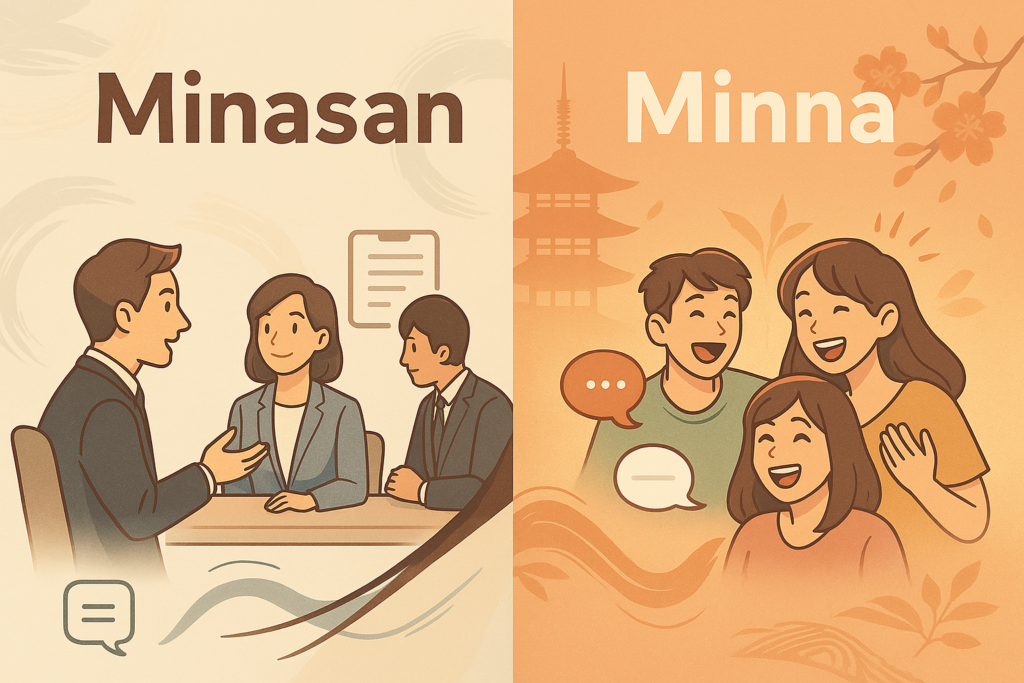Have you ever wondered about the correct way to address a group in Japanese? Perhaps you’ve heard both “minasan” and “minna” in anime or dramas and found yourself confused about when to use each one. You’re not alone! Understanding these common Japanese greeting terms is essential for anyone looking to communicate naturally in Japanese social settings.
In this comprehensive guide, we’ll explore everything you need to know about “minasan” (皆さん), including how it differs from other similar expressions, when to use it appropriately, and practical examples that will help you sound more like a native speaker.
What Does Minasan Mean in Japanese?
“Minasan” (皆さん) is a polite way to address a group of people in Japanese, similar to saying “everyone” or “ladies and gentlemen” in English. The word consists of two parts: “mina” (皆), meaning “all” or “everyone,” and the honorific suffix “san” (さん), which adds politeness and respect.
Minasan is one of the most commonly used greetings when addressing multiple people in formal or semi-formal situations. The basic meaning of minasan is “everyone” in a respectful way.
Minasan vs. Minna vs. Mina-sama: Understanding the Differences
Japanese offers three main ways to address groups, each with different levels of formality:
1. Minna (みんな)
- Formality level: Casual/informal
- Best used with: Close friends, family members, children
- Example: “Minna, konnichiwa!” (みんな、こんにちは!) – “Hello, everyone!”
2. Minasan (皆さん)
- Formality level: Polite/semi-formal
- Best used with: Colleagues, classmates, acquaintances, mixed groups
- Example: “Minasan, ohayou gozaimasu.” (皆さん、おはようございます。) – “Good morning, everyone.”
3. Mina-sama (皆様)
- Formality level: Very formal/respectful
- Best used with: Customers, audience members, people you don’t know, formal speeches
- Example: “Mina-sama, arigatou gozaimashita.” (皆様、ありがとうございました。) – “Thank you very much, everyone.”
When to Use Minasan: Context Matters
Knowing when to use “minasan” instead of other similar expressions can greatly enhance your Japanese communication skills. Here are some common scenarios where “minasan” is the appropriate choice:
Classroom or Work Settings
When addressing colleagues or classmates in a professional or educational setting, “minasan” strikes the perfect balance between formality and friendliness.
Example: “Minasan, kaigi o hajimemasu.” (皆さん、会議を始めます。) Romaji: Minasan, kaigi o hajimemasu. Translation: “Everyone, let’s start the meeting.”
Want to explore Japan’s culture?
Discover Japan’s rich culture, traditions, and hidden gems with our expertly crafted guides. Get insider tips on travel, food, and history. All for free!
Semi-formal Social Gatherings
When meeting with acquaintances or in community settings where some politeness is expected.
Example: “Minasan, omedetou gozaimasu!” (皆さん、おめでとうございます!) Romaji: Minasan, omedetou gozaimasu! Translation: “Congratulations, everyone!”
Public Announcements
When making announcements to a mixed group where some formality is appropriate.
Example: “Minasan, chui shite kudasai.” (皆さん、注意してください。) Romaji: Minasan, chui shite kudasai. Translation: “Everyone, please pay attention.”
Cultural Nuances and Tips for Using Minasan Correctly
Understanding the cultural context behind “minasan” can help you use it more naturally. Similar to how we explored the nuances of “so desu ne” in a previous article, here are some important points to remember:
- Reading the room: Japanese communication is highly context-dependent. If you’re unsure which form to use, observe how others address the group.
- Age considerations: When addressing a group that includes people older than you, it’s safer to use “minasan” rather than “minna.”
- Written communication: In emails or formal written messages, “minasan” or even “mina-sama” is more appropriate than “minna.”
- Combining with other expressions: “Minasan” often pairs with other polite expressions to create common phrases:
- “Minasan, konnichiwa” (皆さん、こんにちは) – “Hello, everyone”
- “Minasan, otsukaresama desu” (皆さん、お疲れ様です) – “Good work, everyone”
Just as we discussed in our article about “yosh”, these small expressions can go a long way in making your Japanese sound more authentic.
Common Mistakes to Avoid When Using Minasan
Even intermediate Japanese learners sometimes struggle with group address terms. Here are some common mistakes to avoid:
- Using “minna-san”: A common error is combining “minna” and “san” to create “minna-san.” The correct form is either “minna” (informal) or “minasan” (polite) without adding an extra “n.”
- Overusing honorifics: Using “minasan” in very casual settings with close friends might create unnecessary distance.
- Inconsistent formality: Addressing a group as “minasan” but then using casual speech patterns can create a confusing tone.
Beyond Basic Greetings: Expanding Your Japanese Communication Skills
While mastering terms like “minasan” is important, becoming truly fluent in Japanese requires a well-rounded approach to learning. If you’re serious about taking your Japanese to the next level, consider exploring our comprehensive Japanese learning guides where we offer free resources to help you on your language journey.
Just as we explored the intricacies of “chigau” in another post, understanding these fundamental aspects of Japanese communication can dramatically improve your fluency.
Conclusion: The Power of Proper Group Address in Japanese
Knowing when and how to use “minasan” appropriately is a small but significant detail that can make a big difference in how you’re perceived when speaking Japanese. By choosing the right form of address based on the situation, you show respect for Japanese social customs and demonstrate your cultural awareness.
Remember: Minasan is the polite way to say “everyone” in Japanese.
Whether you’re giving a presentation, leading a meeting, or simply greeting a group of acquaintances, using “minasan” correctly will help you communicate more effectively and confidently in Japanese.
Q&A Section: Common Questions About Minasan
Q: Is “minasan” more formal than “minna”?
A: Yes, “minasan” is more formal than “minna.” While “minna” is used in casual settings with friends and family, “minasan” adds a layer of politeness appropriate for colleagues, classmates, and semi-formal situations.
Q: Can I use “minasan” with my close friends?
A: While not incorrect, using “minasan” with close friends might create unnecessary formality. In relaxed, friendly settings, “minna” is typically more natural.
Q: What is the kanji for “minasan”?
A: Minasan is written as 皆さん in Japanese, combining the kanji 皆 (mina) meaning “all/everyone” with the hiragana さん (san) honorific.
Q: How do I pronounce “minasan” correctly?
A: Pronounce it as “mee-nah-san” with equal stress on each syllable. Be careful not to add an extra “n” sound (it’s not “minna-san”).
Q: When should I use “mina-sama” instead of “minasan”?
A: Use “mina-sama” in very formal contexts such as customer service, formal speeches, or when addressing people of high status or strangers in business settings.
Ready to take your Japanese learning to the next level? Discover more practical language tips and cultural insights with our free Japanese learning resources today!
Love Japan? Stay in the Loop!
Get the best of Japan straight to your inbox: language, culture & travel insights!




